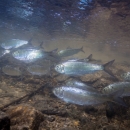About Us
The Virginia Fish and Wildlife Conservation Office is part of a network of field stations located throughout the nation that works to conserve fish and aquatic resource, protect imperiled species and their habitats, and monitor and control invasive species invasive species
An invasive species is any plant or animal that has spread or been introduced into a new area where they are, or could, cause harm to the environment, economy, or human, animal, or plant health. Their unwelcome presence can destroy ecosystems and cost millions of dollars.
Learn more about invasive species .
Our office works primarily in the coastal plain and piedmont regions of Virginia, but we also work in rivers in the mountainous Blue Ridge region, such as the North Fork Shenandoah, and in the Ridge and Valley region, where we find the headwaters of the upper James River.
Our Mission
Since 1871, the U.S. Fish and Wildlife Service has been applying science-based approaches to conservation challenges. We work with our partners and engage the public to conserve, restore, and enhance fish and other aquatic resources for the continuing benefit of the American people. Conservation is at the heart of what we do, and we do this work for the American people, and for the future generations who will inherit our legacy of conserving America’s aquatic resources.
Our History
Established in 1987, the Virginia Fish and Wildlife Conservation Office has been working with the Virginia Department of Wildlife Resources and other partners to re-open Virginia’s rivers to migratory fish like hickory shad and American shad, alewife and blueback herring, Atlantic sturgeon and striped bass, and eastern brook trout. restore our fishing heritage. Since 1999, the office and its partners have removed over 25 barriers to fish passage fish passage
Fish passage is the ability of fish or other aquatic species to move freely throughout their life to find food, reproduce, and complete their natural migration cycles. Millions of barriers to fish passage across the country are fragmenting habitat and leading to species declines. The U.S. Fish and Wildlife Service's National Fish Passage Program is working to reconnect watersheds to benefit both wildlife and people.
Learn more about fish passage , and opened over 1800 miles of rivers. These efforts contribute millions of dollars in economic value to Americans every year, through increased tourism, fishing, and recreation. These projects also improve water quality, increase safety for people recreating in rivers, and protect public and private property from impacts of flooding.



